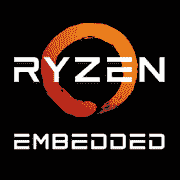AMD Ryzen Embedded R1305G

AMD Ryzen Embedded R1305G: Low-power Processor for Compact Devices
(Current as of April 2025)
Introduction
In an era of miniaturization and increasing demand for energy-efficient solutions, low TDP processors have become key players in the market for compact laptops, industrial systems, and embedded devices. The AMD Ryzen Embedded R1305G is one such chip that combines modest power consumption with sufficient performance for basic tasks. Let’s explore who this model is suitable for and its strengths.
Architecture and Technology Process
Zen on 14 nm: The Legacy of a Proven Platform
The Ryzen Embedded R1305G is built on the first-generation Zen microarchitecture, released back in 2017. Despite its age, the 14-nm technology process from GlobalFoundries remains relevant for niche solutions where stability and low production costs are important.
CPU Specifications:
- 2 cores / 4 threads thanks to SMT (Simultaneous Multithreading) technology.
- Base clock: 1.5 GHz, maximum turbo mode clock — 2.8 GHz.
- Cache: 4 MB L3 (shared between cores) + 512 KB L2 per core.
Integrated Vega 3 Graphics:
- 3 Compute Units (CUs) with a frequency of 1000 MHz.
- Support for DirectX 12, Vulkan, and hardware decoding for 4K H.265 video.
- Maximum resolution: 3840x2160 @ 60 Hz.
Architecture Features:
- Support for DDR4-2400 (up to 32 GB RAM).
- No hardware acceleration for AI tasks (AVX-512 instructions are absent).
- PCIe 3.0 x8 for peripheral connections.
Power Consumption and TDP
With a TDP of 10 watts, the R1305G is an ideal candidate for passive cooling systems and ultra-portable devices.
- Real-world consumption scenarios:
- In idle mode: 2-3 watts (thanks to PowerNow! and C-states technologies).
- Under load (video rendering): 8-9 watts.
- Peak values in turbo mode: up to 12 watts (briefly).
Heat Generation:
- Laptops with this processor often manage without fans, reducing noise and increasing reliability.
- Maximum temperature: 95°C (throttling kicks in).
Performance in Real Tasks
Office Work and Multimedia
- Geekbench 6: 670 (Single-Core) / 1127 (Multi-Core).
- Application Tests:
- Microsoft Office (Word, Excel): no lags even with 10+ tabs open in the browser.
- 4K video (YouTube, local files): smooth playback thanks to hardware decoding.
- Photo editors (GIMP, Lightroom): processing RAW files takes 2-3 seconds longer than on the Ryzen 5 5500U.
Gaming
- CS2 (720p, low settings): 35-45 FPS.
- Dota 2 (768p, Low): 25-30 FPS.
- Indie Projects (Hollow Knight, Stardew Valley): stable 60 FPS.
Turbo Mode:
- Under load on 1-2 cores, the frequency rises to 2.8 GHz, but in multi-threaded scenarios (e.g., rendering), it is limited to 2.3 GHz due to TDP.
Usage Scenarios
Who is the R1305G Designed For?
1. Budget Laptops: models in the price range of $300-400 (e.g., Lenovo IdeaPad 1 or HP 14s).
2. Industrial PCs: terminals, kiosks, IoT devices where stability is crucial.
3. Education: laptops for students (work with texts, Zoom, online courses).
4. Backup Systems: low power consumption management servers.
Not Suitable For:
- Video editing and 3D modeling.
- Contemporary AAA gaming.
Battery Life
- Laptops with the R1305G and a 40-50 Wh battery demonstrate 8-10 hours of operation under moderate load (web surfing, office tasks).
- Power-saving Technologies:
- PowerNow!: dynamic frequency and voltage scaling.
- Core Parking: disabling unused cores.
- Adaptive screen brightness: integration with light sensors.
Tip: For maximum battery life, choose devices with low-brightness IPS screens (250 nits) and SSDs instead of HDDs.
Comparison with Competitors
AMD vs Intel vs Apple
1. Intel Celeron N5100 (Jasper Lake, 10 W):
- Weaker in multi-threading (4 threads without SMT), but better in single-core (Geekbench 6: ~720).
- Intel UHD graphics are 15% slower than Vega 3.
2. Apple M1 (5 nm, 10 W in basic tasks):
- Single-Core: 2300, Multi-Core: 8300 (Geekbench 6).
- Device prices starting from $999 (MacBook Air).
3. Previous Generations of AMD:
- A9-9425 (Excavator, 15 W): 30% slower in multi-threaded workloads.
Conclusion: The R1305G outperforms Intel in graphics integration but lags behind the Apple M1 in every aspect except price.
Pros and Cons
Strengths:
- Low device costs.
- Passive cooling.
- Support for 4K displays.
Weaknesses:
- Outdated technology process (14 nm compared to 7 nm in the Ryzen 5000).
- Limited multi-threaded performance.
- No support for PCIe 4.0.
Laptop Selection Recommendations
1. Device Type: ultrabooks or budget Chromebooks (e.g., ASUS ExpertBook B1).
2. Optimal Configuration:
- 8 GB of RAM (minimum for Windows 11).
- 256 GB SSD (NVMe preferred over SATA).
- Matte screen with a resolution of 1920x1080.
3. Avoid:
- Laptops with HDDs and TN screens.
- Models without USB-C.
Final Conclusion
The AMD Ryzen Embedded R1305G is a processor for those seeking a cheap and energy-efficient solution without high performance requirements.
Key Benefits:
- Adequate power for office, study, and video streaming tasks.
- Quiet operation without fans.
- Device prices starting from $300.
Target Audience:
- Students.
- Office workers.
- Users of backup PCs.
If your budget is limited and your needs are basic, the R1305G will be a reliable choice. However, for gaming or professional tasks, consider the Ryzen 5 7530U or Intel Core i3-N305.
Basic
CPU Specifications
Memory Specifications
GPU Specifications
Benchmarks
Compared to Other CPU
Share in social media
Or Link To Us
<a href="https://cputronic.com/en/cpu/amd-ryzen-embedded-r1305g" target="_blank">AMD Ryzen Embedded R1305G</a>